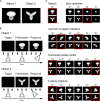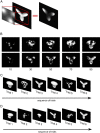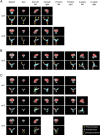Multifeatural shape processing in rats engaged in invariant visual object recognition
- PMID: 23554476
- PMCID: PMC6618908
- DOI: 10.1523/JNEUROSCI.3629-12.2013
Multifeatural shape processing in rats engaged in invariant visual object recognition
Abstract
The ability to recognize objects despite substantial variation in their appearance (e.g., because of position or size changes) represents such a formidable computational feat that it is widely assumed to be unique to primates. Such an assumption has restricted the investigation of its neuronal underpinnings to primate studies, which allow only a limited range of experimental approaches. In recent years, the increasingly powerful array of optical and molecular tools that has become available in rodents has spurred a renewed interest for rodent models of visual functions. However, evidence of primate-like visual object processing in rodents is still very limited and controversial. Here we show that rats are capable of an advanced recognition strategy, which relies on extracting the most informative object features across the variety of viewing conditions the animals may face. Rat visual strategy was uncovered by applying an image masking method that revealed the features used by the animals to discriminate two objects across a range of sizes, positions, in-depth, and in-plane rotations. Noticeably, rat recognition relied on a combination of multiple features that were mostly preserved across the transformations the objects underwent, and largely overlapped with the features that a simulated ideal observer deemed optimal to accomplish the discrimination task. These results indicate that rats are able to process and efficiently use shape information, in a way that is largely tolerant to variation in object appearance. This suggests that their visual system may serve as a powerful model to study the neuronal substrates of object recognition.
Figures










Similar articles
-
Invariant visual object recognition and shape processing in rats.Behav Brain Res. 2015 May 15;285:10-33. doi: 10.1016/j.bbr.2014.12.053. Epub 2015 Jan 2. Behav Brain Res. 2015. PMID: 25561421 Free PMC article. Review.
-
Accuracy of Rats in Discriminating Visual Objects Is Explained by the Complexity of Their Perceptual Strategy.Curr Biol. 2018 Apr 2;28(7):1005-1015.e5. doi: 10.1016/j.cub.2018.02.037. Epub 2018 Mar 15. Curr Biol. 2018. PMID: 29551414 Free PMC article.
-
Object similarity affects the perceptual strategy underlying invariant visual object recognition in rats.Front Neural Circuits. 2015 Mar 12;9:10. doi: 10.3389/fncir.2015.00010. eCollection 2015. Front Neural Circuits. 2015. PMID: 25814936 Free PMC article.
-
Transformation-tolerant object recognition in rats revealed by visual priming.J Neurosci. 2012 Jan 4;32(1):21-34. doi: 10.1523/JNEUROSCI.3932-11.2012. J Neurosci. 2012. PMID: 22219267 Free PMC article.
-
Visual Object Recognition: Do We (Finally) Know More Now Than We Did?Annu Rev Vis Sci. 2016 Oct 14;2:377-396. doi: 10.1146/annurev-vision-111815-114621. Epub 2016 Aug 3. Annu Rev Vis Sci. 2016. PMID: 28532357 Review.
Cited by
-
Invariant visual object recognition and shape processing in rats.Behav Brain Res. 2015 May 15;285:10-33. doi: 10.1016/j.bbr.2014.12.053. Epub 2015 Jan 2. Behav Brain Res. 2015. PMID: 25561421 Free PMC article. Review.
-
Functional specialization in rat occipital and temporal visual cortex.J Neurophysiol. 2014 Oct 15;112(8):1963-83. doi: 10.1152/jn.00737.2013. Epub 2014 Jul 2. J Neurophysiol. 2014. PMID: 24990566 Free PMC article.
-
Linear and Non-Linear Visual Feature Learning in Rat and Humans.Front Behav Neurosci. 2016 Dec 23;10:235. doi: 10.3389/fnbeh.2016.00235. eCollection 2016. Front Behav Neurosci. 2016. PMID: 28066201 Free PMC article.
-
Shape similarity, better than semantic membership, accounts for the structure of visual object representations in a population of monkey inferotemporal neurons.PLoS Comput Biol. 2013;9(8):e1003167. doi: 10.1371/journal.pcbi.1003167. Epub 2013 Aug 8. PLoS Comput Biol. 2013. PMID: 23950700 Free PMC article.
-
Acute spinal cord injury serum biomarkers in human and rat: a scoping systematic review.Spinal Cord Ser Cases. 2024 Apr 13;10(1):21. doi: 10.1038/s41394-024-00636-3. Spinal Cord Ser Cases. 2024. PMID: 38615029 Free PMC article.
References
-
- Chelazzi L, Rossi F, Tempia F, Ghirardi M, Strata P. Saccadic eye movements and gaze holding in the head-restrained pigmented rat. Eur J Neurosci. 1989;1:639–646. - PubMed
Publication types
MeSH terms
LinkOut - more resources
Full Text Sources
Other Literature Sources
